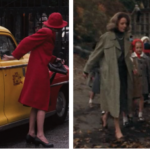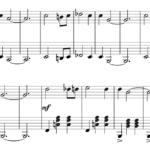A Bitter-Suite Romance: Michael and Kay’s Hotel Scene
By Max Sala
Many scenes in The Godfather—Connie and Carlo’s wedding, the baptism and assassination montage—are full of self-conscious bravura, but it’s the quieter, shorter scenes that lend the film its emotional depth and narrative intrigue. Consider Michael and Kay’s hotel scene: lasting seventy-five seconds, and with only 9 lines of dialogue, this scene courses by, brief and seemingly unexceptional. The episodes that follow—Michael’s visit to his father at the hospital, McCluskey’s assault on Michael—eclipse this scene and perhaps push it to the back of the viewer’s consciousness.
But let us return to the hotel. If we inspect the scene’s formal features—those of sound, mise-en-scène, and cinematography—we can see how those features help establish a narrative problem for the couple’s relationship. Indeed, even without a close analysis, the tension between Michael and Kay is striking. This scene is the first time they experience that tension, but it lingers and refuses resolution, even at the film’s end. In this way, the hotel scene functions as a crucial marker within The Godfather’s plot, a harbinger of the clanging discord that comes to define Michael and Kay’s relationship.
***
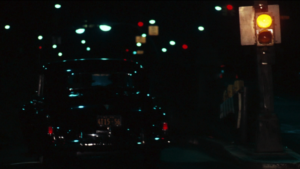 The transition to the scene establishes an atmosphere of tension. Two unidentified men drive Michael into the city to meet Kay at the hotel. The camera jump-cuts from a shot of Michael in the backseat to the car’s bumper. We watch the car pass a flashing yellow streetlight on its right side. It is nighttime, the road is clear, and the only sound effects we hear are the tires hissing against the asphalt. This shot lasts only twelve seconds but establishes a sequence and tone. The direct sound of the tires seems menacing and heightens the peril of events so far—Vito Corleone’s attack, Paulie Gatto’s assassination.
The transition to the scene establishes an atmosphere of tension. Two unidentified men drive Michael into the city to meet Kay at the hotel. The camera jump-cuts from a shot of Michael in the backseat to the car’s bumper. We watch the car pass a flashing yellow streetlight on its right side. It is nighttime, the road is clear, and the only sound effects we hear are the tires hissing against the asphalt. This shot lasts only twelve seconds but establishes a sequence and tone. The direct sound of the tires seems menacing and heightens the peril of events so far—Vito Corleone’s attack, Paulie Gatto’s assassination.
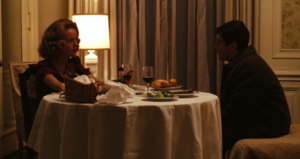 A slow dissolve transitions us into the hotel room and is joined with a sound bridge, Irving Berlin’s “All My Life.” This song—a slow-tempo ballad often performed by a female vocalist addressing her lover—presents a surprising counterpoint to the preceding events, easing us into the scene and suggesting an emotional uplift in the narrative. It overlaps with the dialogue and is part of the film’s diegesis: the song seems to play somewhere in the background. The music is muted and subtle, softly complementing the dinner’s romantic atmosphere—a small round table and white tablecloth; red wine and steak; Kay’s lipstick-red blouse with a sweetheart neckline and puffed sleeves, Michael’s oxford shirt and tie. A lamp in the corner provides diffused light that illuminates Kay’s face. Her cheeks look cherubic; her skin, soft and warm.
A slow dissolve transitions us into the hotel room and is joined with a sound bridge, Irving Berlin’s “All My Life.” This song—a slow-tempo ballad often performed by a female vocalist addressing her lover—presents a surprising counterpoint to the preceding events, easing us into the scene and suggesting an emotional uplift in the narrative. It overlaps with the dialogue and is part of the film’s diegesis: the song seems to play somewhere in the background. The music is muted and subtle, softly complementing the dinner’s romantic atmosphere—a small round table and white tablecloth; red wine and steak; Kay’s lipstick-red blouse with a sweetheart neckline and puffed sleeves, Michael’s oxford shirt and tie. A lamp in the corner provides diffused light that illuminates Kay’s face. Her cheeks look cherubic; her skin, soft and warm.
These details of the mise-en-scène recall, and seem to recreate, the moment between Michael and Kay at Connie and Carlo Rizzi’s wedding, when they were eating by themselves with red wine and a white tablecloth, in formal attire, under soft-quality outdoor lighting. Berlin’s song plays with the romance of that moment and underscores these formal features, establishing an intimate and enchanting mood:
I just want the right to love you
All of my life
Just the right to take care of you
All of my life
His lyrics suggest a storybook-like romance, a budding passion that charges each person’s enduring commitment to one another. The brass section’s dreamy crescendos, the percussion section’s dramatic yet steady beat: these musical features seem to frame Michael and Kay’s relationship through the sweet dreamwork of Tin Pan Alley.
Alas, these formal features only suggest intimacy; they actually function as ironic counterpoints to the scene’s undercurrents of discord. In fact, what we are watching is the dissolution of a romance, or at least the dissolution of the more idealized romance that the film initially depicts. This dinner is sour.
***
Consider the conversation between Michael and Kay. Initially, fifteen seconds of silence precede their dialogue. Besides the background music, we only hear sound effects of their meal—forks scraping plates, clothes rustling, the dull thud of Michael setting his wine glass on the table. Their silence creates an edgy atmosphere and implies some dilemma before any dialogue even occurs. Once it does begin, the dialogue is brief; each character speaks using one-sentence replies. Kay poses quick questions: can she accompany Michael to the hospital? When she will see him again (a question she repeats when at first Michael avoids answering her)? Kay uses the imperative mood when she speaks: she appears and is literally dependent on Michael.
Michael’s replies, meanwhile, are short and vague: he denies Kay’s requests to accompany him, declares that he does not want Kay to “get involved,” and avoids addressing when they will meet again. Michael uses the indicative mood—he makes decisions and is in control. Their conversation could simply reveal the sorts of tensions that beset all romantic relationships eventually, but we cannot help but feel something larger is at stake for this relationship.
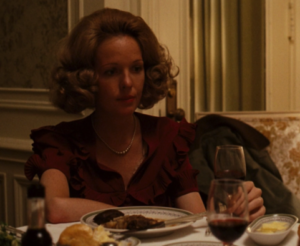
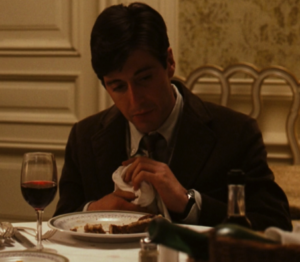 The halting rhythm of the camera draws out the scene’s feeling of awkwardness. The scene’s establishing shot shows Kay sitting at the dinner table. The camera frames her using a point-of-view vantage and positions us in a medium close-up. Immediately we notice her red blouse, princess-length pearl necklace, coiffed hair, and hesitant face. Kay appears vulnerable, and since that vulnerability charges the establishing shot, we know it will inform the scene. The camera transitions to Michael wadding his napkin, looking down and avoiding eye contact with Kay.
The halting rhythm of the camera draws out the scene’s feeling of awkwardness. The scene’s establishing shot shows Kay sitting at the dinner table. The camera frames her using a point-of-view vantage and positions us in a medium close-up. Immediately we notice her red blouse, princess-length pearl necklace, coiffed hair, and hesitant face. Kay appears vulnerable, and since that vulnerability charges the establishing shot, we know it will inform the scene. The camera transitions to Michael wadding his napkin, looking down and avoiding eye contact with Kay.
This counter shot uses Michael’s icy attitude as a response to Kay’s diffidence, enabling the camera to characterize Kay as subordinate, as though she needs something from Michael. A brief medium two-shot reveals both characters across from one another at the table. Here the camera captures their disengagement. Their initial silence emphasizes the physical distance the camera exposes, and as a result the dinner feels forced and uncomfortable. We feel the discomfort—Kay’s pain and Michael’s angst.
Once the dialogue begins, the camera reemploys a shot/counter shot technique that parallels Michael and Kay’s responses until the scene ends. Each counter shot lasts approximately five seconds, and the more we watch, the more engrossed we become by the dialogue:
KAY: When will I see you again?
MICHAEL: Go back to New Hampshire, and I’ll call you at your parents’ house.
KAY: When will I see you again, Michael?
MICHAEL: I don’t know.
As the camera alternates between Kay and Michael, the montage produces two effects. First, the shots isolate each spoken line, underscore them as wooden and clipped, and intimate the anxiety Michael and Kay both suppress. Second, we become anxious. We identify with Kay’s vulnerability and await Michael’s replies, anticipating each counter shot. Yet because he is so evasive, and since their emotional turmoil functions as the subtext of the scene, we are left in suspense, with more questions than answers, frustrated and dissatisfied. At this point, the scene’s romantic picture crumbles. We realize now that Berlin’s song functions more as a lament for Michael and Kay’s romance than as an expression of it.
***
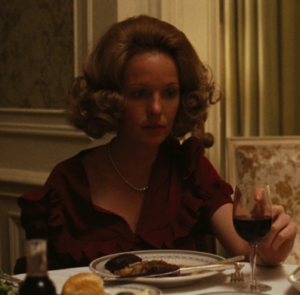 We end with a shot of Kay staring at her wine glass. The camera once again positions us at a medium close-up, reinforcing her pain and hesitation. We know Sollozzo’s attack has unnerved Michael. We might foresee his looming retaliation. Perhaps we even correctly infer his ultimate fate from these character developments. But empathizing with Kay’s pain, we question if her relationship with Michael will last.
We end with a shot of Kay staring at her wine glass. The camera once again positions us at a medium close-up, reinforcing her pain and hesitation. We know Sollozzo’s attack has unnerved Michael. We might foresee his looming retaliation. Perhaps we even correctly infer his ultimate fate from these character developments. But empathizing with Kay’s pain, we question if her relationship with Michael will last.
This loose end unsettles us. It is true, of course, that Michael and Kay do ultimately reunite. It is also true that, as an outsider to the Corleone world, Kay is presented at first as a figure for the audience: when Michael explains his family to her in the wedding scene, he is in effect explaining his family to us in the audience, and she becomes a key figure of identification for us (up to the very last moment of the film). Our anxiety derives less from a fear that they will indeed break up, and more from the scene’s tragic irony: Kay’s world hopelessly opposes Michael’s, and yet she loves him. Whatever form her relationship with Michael does take, Kay—dependent, vulnerable, and unlike Michael in too many ways—will remain relegated to the Corleone family’s periphery. This alienation accounts for why she appears dependent and vulnerable: we sense too that, since Michael will always subordinate Kay to the family business, her alienation will persist.
This scene, then, does not merely establish a narrative problem. It reveals a fatal flaw in their relationship—the gulf between Michael and Kay that, whatever the melody playing in the background, neither one can bridge.


